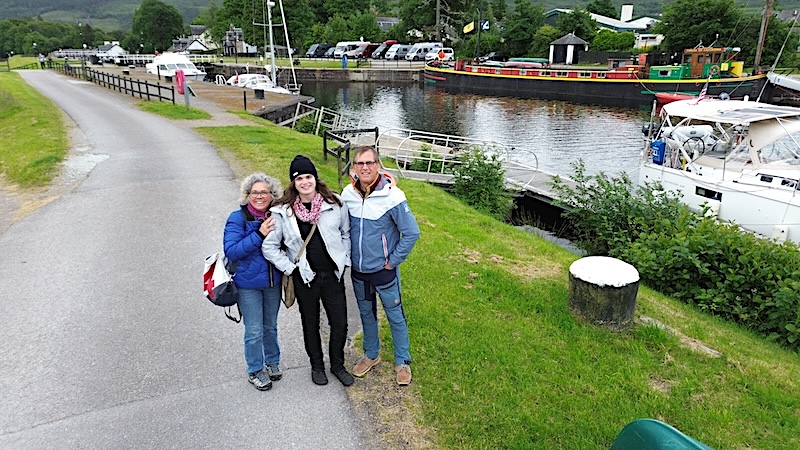We face a lot of crossroads in our navigational planning, not unlike the decisions for planning a trip on land. Should we take the highway into the big city, the rural road through quaint little villages lost in time, or the dirt road cut by early settlers leading to dramatic vistas. The best path before us was clear though. When one looks closely at a map of Scotland and zeros in on the Highlands region in the north, a deep cut through the land is immediately clear, as if drawn by the steady hand of a draftsman. It is a fascinating geological feature of this region where high mountains rise on either side of a natural fault line and lakes – or properly called ‘lochs’ – hide the depth in between, which can drop to over 200 meters deep. These long skinny lochs, the most famous of which is Loch Ness, have been used for many centuries to move people and goods across the Highlands. Castles along their shores are a testament to the need to defend against warring clans and the conflicts between the Scots and the English, including the famous Jacobite Uprising of 1745. In 1822, these narrow waterways were connected, from Inverness to Fort William with the goal of improving commerce and minimizing the risk to mariners of navigating the treacherous waters between mainland Scotland and the Orkneys, a matter with which we had some firsthand experience. The waterway, called the Caledonian Canal, is 50 nautical miles long consisting of 29 locks and 11 bridges. It is now mostly used by pleasure boats – both privately owned like our Sea Rose and a variety of charter boats and long skinny luxury cruise boats. Sailing south from Orkney, we could have run the gauntlet through the entire length of the Pentland Firth and then proceeded over the top of mainland Scotland to get to the highly touted Hebrides islands, or we could use the Caledonian Canal to get there and be safer and have a lot more fun exploring inner Scotland in the process. Like hitting the proverbial Easy button, this was a no-brainer.

We gave our daughter Alaska the choice to join us on the canal transit or to explore the coastal Hebrides area. We were delighted that she chose the former. It would also be helpful to have an extra set of hands to negotiate the locks.

Transiting the Caledonian Canal from either end is like jumping from the frying pan into the fire. At Inverness, the canal designers wasted no time in their goal to seize elevation. The ‘Muirwood Flight’ consists of 4 locks, one after the other, that raise you up 10 meters. Fortunately, the flight of locks is a short walk from the Seaport Marina and this gave us the chance to watch a sailboat come up the lock the day before we would ascend. We also chatted with the lock tenders so we could know more about what to expect.

Because of the number of locks in this flight, and the need to manage boats wanting to transit in both directions, you are required to make a reservation beforehand. Our time slot was 9:45am, and we were ready – and a bit nervous – like eager grade school kids on the first day of classes. We were told that a barge was coming through at the same time and that we must let them enter the lock first. By ‘barge’, they really meant ‘boutique canal cruise boat’. As we followed them into the first lock chamber, we could see through large picture windows the passengers dining on an exquisite breakfast, waited on by swankily dressed crew members. We, on the other hand, were outside in our bulky foul weather gear, hurrying around to make sure we got lines up to the lock tender while not being pushed into boats in front, behind and to the side of us. This work of moving a sailboat upwards, instead of across the seas of the world, was a wholly different type of hard work.
Here at the Muirtown flights, once you were raised up to the top of the first lock, they required you to step out onto the lock wall and walk the boat into the next lock. In our previous experience, that of transiting the 35 locks of the Erie Canal (include link), we always used the boat’s engine to move between locks in a flight. But other than the physical strain of the work, I liked this new approach. An unspoken bit of unpleasantness when traveling a lock system is the diesel exhaust from all of the boats down in the windless, non-circulating chamber of the lock. The barge with the luxury breakfast diners was the biggest culprit, running their engines through the whole flight.
Soon enough we had walked Sea Rose into the fourth lock and, once filled to the top, the gates opened and we were free to start making some lateral movement. As we putt-putt-ed down the canal, with green banks on both sides overgrown with everything that flourishes with lots of rain and a rich topsoil, the scene brought me back to the hours we spent driving our boat past farmland and grazing animals and deep woods on our early days of the Erie Canal. It was far from any temperamental headwinds and currents, as well as decisions on when to reef sails or how to manage an overnight watch schedule. In other words, it was pure bliss!

After two bridges swung open and out of our way and another – this time very short – lift lock, we were emptied out into the loch that gets all of the attention on the Caledonian, the Loch Ness. Nessie, as she is fondly called – presumably to sell more stuffed animals at souvenir shops to young kids in a less threatening, kinder, gentler world – was absent from the surface of the waters as we pushed onward a few miles to a mooring buoy off the Urquhart Castle, our home for the night.
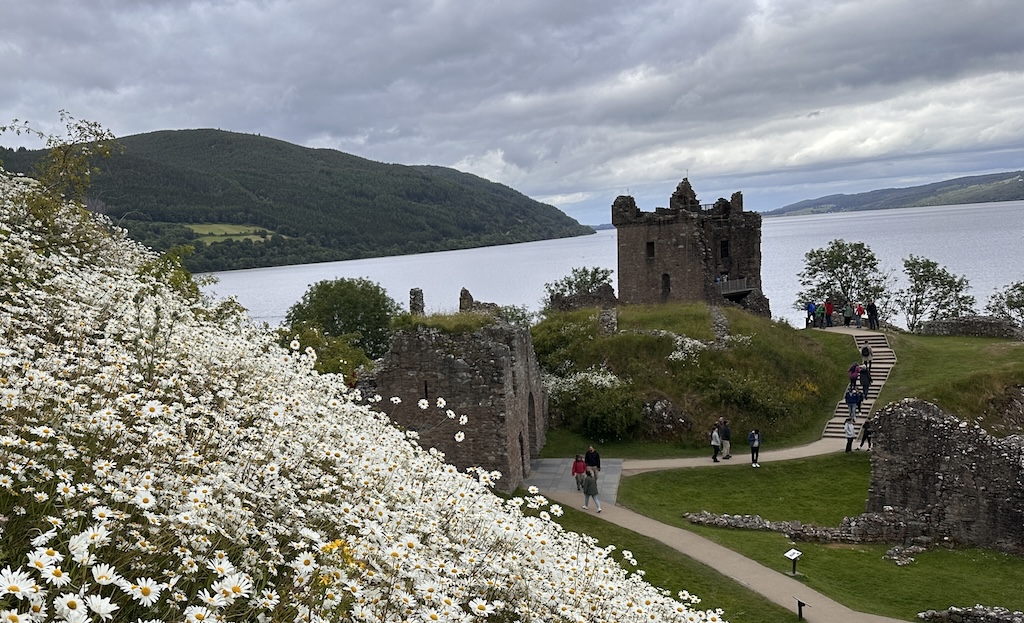
The grounds were open until an impressively late 8pm, giving us plenty of time to get into the mindset of this once great defensive stronghold that was literally on the boundary between warring clans of the Scots and the English. Dating back some 1000 years, where progressively more extensive walls, towers and keeps were built on top of prior foundations, this site was well set up for visitors, with helpful docents positioned along the pathways ready to answer questions from curious people like us who only knew about the Wars of Scottish Independence and the Jacobite Uprising from binge watching ‘Outlander’. Let’s just say that the Scots and the English have been at each other’s throats for a very long time. And it continues. The 2014 vote for Scotland succession was narrowly defeated, with 44% of the populace voting in favor of independence. Sometimes it is good to be in a position as an outsider to these events, where we could look upon these ruins with a simple appreciation of their historic merit, and the troop’s good fortune to be located on the banks of this majestic loch and landscape.

At the far end of Loch Ness is the town of Fort Augustus, where, after several hours of relaxing following an unproductive search for Nessie, we were suddenly back in the throws of a different monster – this time, a five lock flight. In addition to being on the canal, Fort Augustus is a popular tourist stop along the way for road travelers sightseeing in the Highlands. So instead of a handful of well-heeled ‘barge’ passengers, the lock walls were nearly shoulder-to-shoulder full of camera-clicking gawkers. It was an ever-so-tiny glimpse into the paparazzi effect that took down dear sweet Princess Diana. I get it. If I was driving around Scotland and came to this charming little oasis of a town with five locks running up the center of it like a Main Street thoroughfare, I would be clicking away with reckless abandon too.
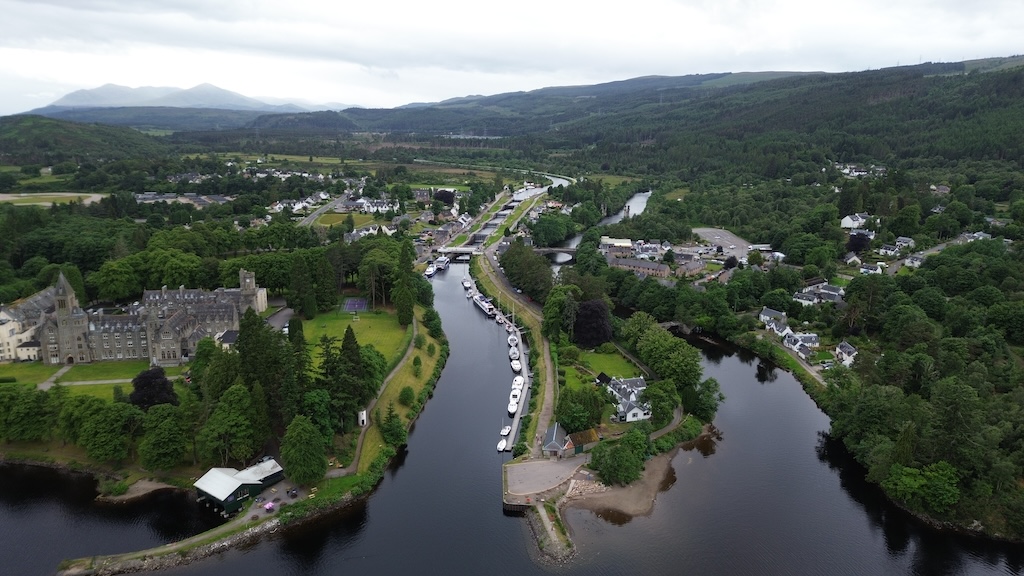

Although much of our experience on the canal reminded us of the Erie Canal, the lock tenders here were in a league of their own. They not only helped everyone with their lines, as we first witnessed back in Inverness, but here they walked down to the waiting pontoon and visited each boat, making sure everyone was clear on the procedures, timing, what side to tie to, and how to move forward to the next lock. As we transited each lock, they would walk around to answer any further questions and make sure any help needed was delivered. By contrast, the Erie Canal lock keepers stayed in their control tower, reachable by radio but only to communicate the next opening time. One or twice they would come out to the lock wall and say a brief hello. So far, I was really liking the kinder, gentler UK approach. They should really make a stuffed version of the Lock Tender for the souvenir shops. I would suggest the name ‘Tendie’!
By the time we had reached the fifth lock chamber, the crowds of onlookers had thinned out considerably – something about the tempting smell of fish and chips winning out over the monotony of another lock chamber filling with boats and water. (But it didn’t get old for us. The torrent of water that was released as they initially filled the lock chamber took tremendous coordination to prevent the boat from careening into the boat across from you.

We were delighted to reach the top and secure an overnight spot on the quiet, tranquil, more-ducks-than-people upper waiting pontoon. Sadly, most of the shops that attract so many visitors were closed by the time we finished our ‘flight’. But a few of us did at least secure a tasty serving of fish and chips. It is not good to let temptations fester for too long!
Given the extreme depth of the lochs, there are not a plethora of options for overnight stays along the canal route. We had found two of the more popular stops – Urquhart Castle and Ft Augustus. The next logical stop was – sad that it had come so quick – Corpach, the western terminus of the canal. At just 16 miles away, it normally would not be a daunting distance for Sea Rose. However, traveling in and out of locks and waiting for traffic to clear can slow down the typical boat speed considerably. Our previous day’s average speed was just 2.5 knots, a common pace for walking! We dropped our lines at 8am and soon entered Kytra lock, on our own, without the worry of bumping into other boats. Peaceful overnight pontoons had been installed on both the bottom and top ends of the lock for boaters who might have thought Ft Augustus was too much pomp and circumstance. As we progressed, the canal became thinner and thinner, with channel markers identifying the path of safety around bends and past overgrown trees on the banks projecting at a 45 degree angle in their eager search for clear sunshine. We entered another lock at Cullochy that appeared suddenly around a bend which had an even more chill vibe to it.
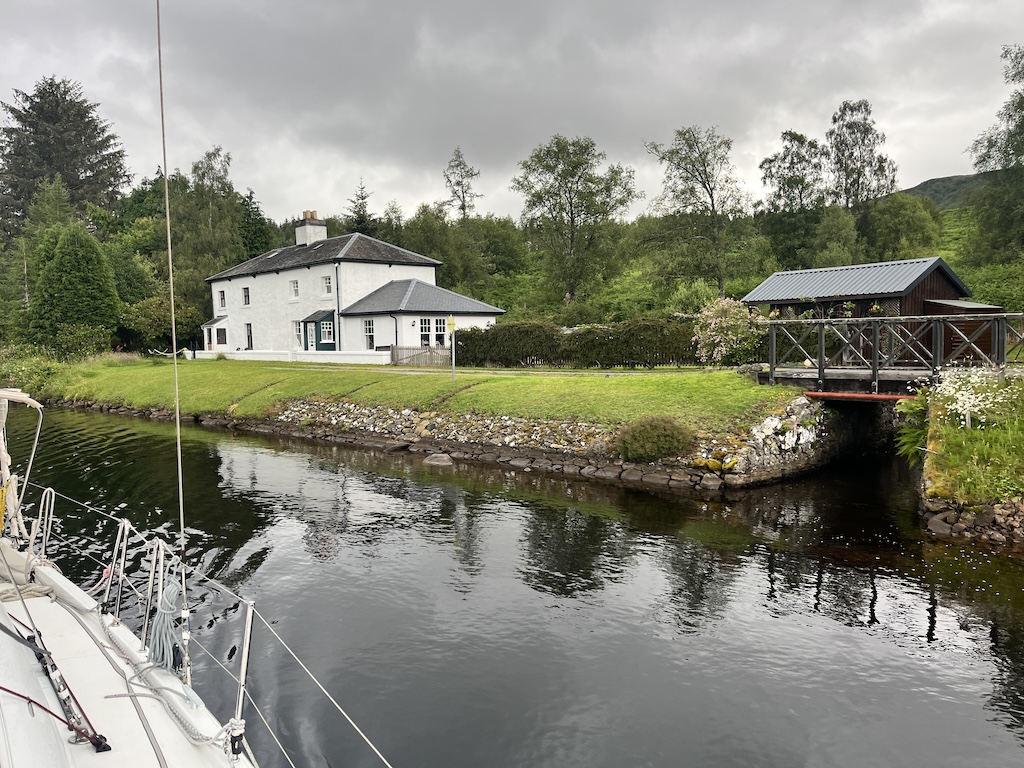
The old keepers cottage looked like it had been turned into a cool holiday rental. From here, the canal opened up into Loch Oich, the high point of the canal, and then immediately narrowed for a swing bridge at Lagan followed by double locks. From here onward, we would be downlocking to the west coast. To our surprise, the lock tender lowered us down more than the customary distance, opening the gates into an already open second lock. It was a two for one deal, with an extra door prize of entering the catchy named Loch Lochy.

Strong head winds slowed our progress, as did the need to navigate around strategically placed buoys marking the shallows of this loch that from the surface looked like it had plenty of deep water, like a high mountain lake. We were happy to get past the open water as Loch Lochy narrowed into the entrance at Gairlochy lock. The lock tender informed us that they were going on lunch break soon and the next opening would not be for another two hours. You can now understand why we made no better than a walker’s pace. It was also another sharp contrast with the Erie Canal. I can’t remember being told to wait for the lock tender’s lunch period to end. Technically, all the locks were open from 8am to 6pm. But in reality, we were far from the hustle and bustle of London or New York. An 8am opening might mean the first passage is at 9am. To close at 6pm, many locks required you to pass through by 4ish. And then there’s the lunch break in the middle of the day. If this was the Caribbean, we’d call it island time. I’ll call it highland time!
We were waiting in rain which was nearly horizontal due to the strong and persistent winds. As we ate our lunch, we met the skipper of a neighboring UK boat with the ‘damn-I-can’t-get-the-song-out-of-my-head’ name of Daydream Believer. He mentioned they have watched many of our videos, especially the technical ones. It warmed our hearts on this raw day. Across from us in the lock, the boat Mara pulled in, hailing from Seattle. It was the flipside of the British Invasion – two US flagged boats in a single lock!
From Gairlochy, this portion of the man-made canal follows a path high above the valley floor, with thickly wooded banks. On the valley floor side of those banks is an earthen and sometimes concrete barrier, all that separates us from being washed down into farmland far below. Navigating a canal requires immense trust in the competency of engineers and laborers.

Rain, and more rain. Cold and raw. A brief moment of sunshine raises hope, like being sneaked a food scrap from the masters of the universe dining at their table made by the cloud layer, relaxing in the sun. We arrive at Banavie, the upper lock waiting area for Neptune’s Staircase, where we will encamp for the night. This will be the grand finale of the canal journey. The staircase consists of eight locks, all back to back! We walked the flight, like Mikaela Shiffrin studying the intricacies of each turn of the downhill ski course she is about to tackle. At the bottom, our work will not be done. There are still two more locks, a bridge, a waiting area, and then the final sea lock at Corpach that drops us into the tidal water of Loch Linnhe. And the rain continues. When we noticed that the next day was forecasted to be extremely high winds blowing in our faces up Loch Linnhe, we punted. Searching, like parents coming up with a plan B when the weather threatens to spoil the excitement of a child’s birthday party, we bought tickets for a ride on the train to Mallaig.

On this route, there are two choices of trains. One is the traditional ScotRail line that runs all throughout the Highlands. The second is the heavily marketed Jacobite Steam Train, that has an on again/off again relationship with the local railroad safety commission. Their carriages are vintage – part of the attraction of their service – but with their age, they lack the proper backup safety mechanism on their passenger doors. As soon as this Spring, it was not clear if they would be given authorization to run their twice daily service between Ft William and Malliag. When ticketing became available, all seats for the season were snatched up. We were left to ride ScotRail, with our only consolation being that we were slightly safer and paid MUCH less for the tickets. The Jacobite Steam Train locomotive and carriages will look very familiar to Harry Potter fans, as the filming crew used a nearly identical set in the movie series. The association continued. At about half the distance to Mallaig, the tracks take a turn inward from the coast and cross over the large Glenfinnan viaduct to the other side of a river valley. This viaduct is burned into the imagery of any Harry Potter movie goer. It felt like the train was going to tip over as everyone scrambled to the outside windows to record the grand scene for posterity on their camera phones. All of a sudden, the rain outside didn’t seem so hard to take as we were whisked along in the warm (and safe) comfort of our ScotRail car.
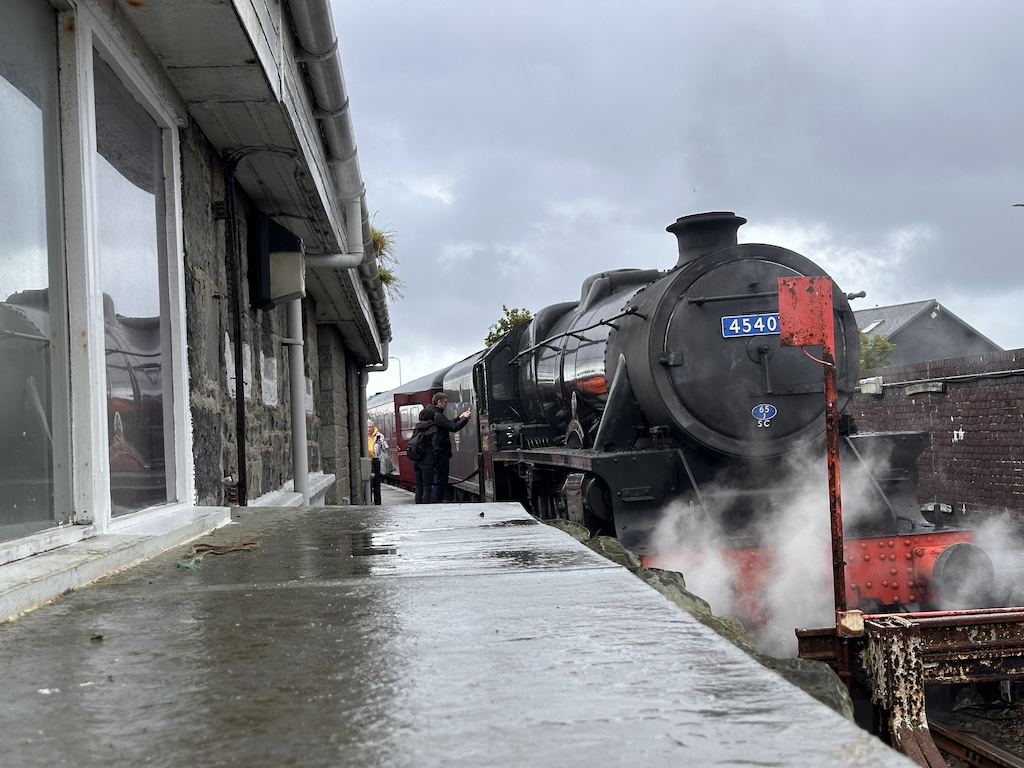
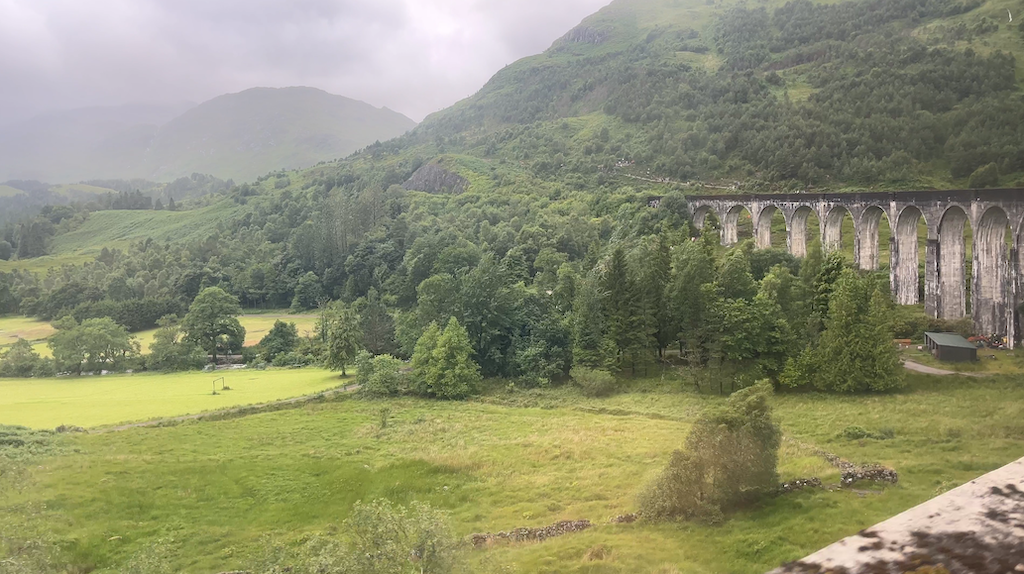
Malliag is the end of the line for train passengers and the beginning of the line for those destined to travel to the island of Skye via ferry. We dodged the throngs with their roller bags to find a warm spot inside for lunch, while reading news of friends back home in New England complaining, insufferably, about the extreme heat. Surely this isn’t the future of climate change, where neither group gets what they want, is it?! We find every reason to linger longer at our table within reach of a wood-burning fireplace, until our motives were awkwardly familiar to the wait staff.
Banished to the streets, we, like the other tourists of the day, huddled under store front awnings, timing our hops to the next safe coverage from the rain like carefully chosen steps across the stones of a rising river. But we could feel good about our overall strategy. Just out to sea from the harbor entrance, the tempest raged as if driven by the anger of the gods dining above. Perhaps dessert was not to their liking. Clearly we were getting the unvarnished weather experience, for these last few days were how I pictured life in Scotland to be.

In the morning, with a slightly better subsiding rain, the lock tenders took us promptly at 8am. We were not the only ones with the idea to stay put the previous day and get moving on this day. A total of 7 boats squeezed into the lock. We knew it had to be a noteworthy accomplishment when one of the lock tenders mounted a camera to record the action. There were so many boats, the last arrival had to go in the middle between two other boats attached to the lock wall – and have nothing but the adjacent boat to hold on to as the waters swirled on the way down.

With eight locks, we ended up getting into a rhythm which made it much less stressful. Seeing each of the other crews getting the hang of handling their lines was comforting as well. After the additional two locks at the bottom and the swing bridge, our progress was once again stymied, not by the growling stomaches of the lock tenders, but by the low tide on the other side of the Corpach sea lock. If they were to lock us down and out, we’d all run aground – not the way we had envisioned the end of canal transit to be, with all of us on the evening news cycle. At least that’s what they told us; it was suspiciously close to lunch time and we were told the wait would be three hours. Anxious that we still had 30 nautical miles to go to Oban for the night, we rushed into the lock to be the first one’s out on the other side, like a racehorse restless in the starting gate.

Back in the world of tides and currents, we motored the full distance to Oban under gray skies. It would have been a respectfully full day if we had simply stopped at nearby Fort William, after our start at 8am, but life on a boat does not release one from the chains of time and place. Alaska had a bus to catch from Oban for her own 6 hour odyssey of public transit to get back to Inverness and her flight home. When we did pull into the marina at Oban at nearly 9pm, eager to find a celebratory last-dinner-together venue, we found plenty of pubs but their kitchens were all closed. Apparently Friday nights in Scotland were no reason more than any other day of the week to linger, French-style, over dinner with friends and family. We finally found out where the few hungry souls had wandered – a cafeteria-style space reminiscent of a low-budget wedding venue, but serving delicious food with a side of boisterous teenagers.
Oban is the epicenter of life in this region. Historically, it was known as the center of the fisheries industry. Now, it is a popular stop for travelers exploring western Scotland and a convenient place to pick up or drop off crew with its convergence of rail and bus routes. We were surprised to see a lot of sailboats for bare-boat or crewed charter as well, but it makes sense given its strategic location to the Hebridean islands and other famous cruising grounds such as Skye and Mull.
With its great transportation connections – an attribute difficult to find in these rural and mountainous Highlands – we bid adieu to Alaska as she embarked on her own odyssey of three buses, a train, and three flights to make it back home to New England. As any parent of a grown adult will tell you, the opportunities to spend time together get more challenging with each passing year. I look now with envy at the parents of young kids, with so much time together, so much wonder, so much innocence. But we can’t go back, so we make the best of the time ahead.

